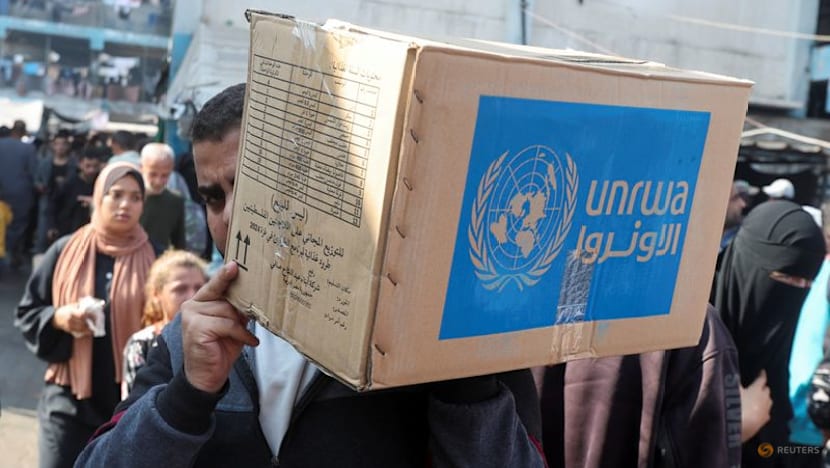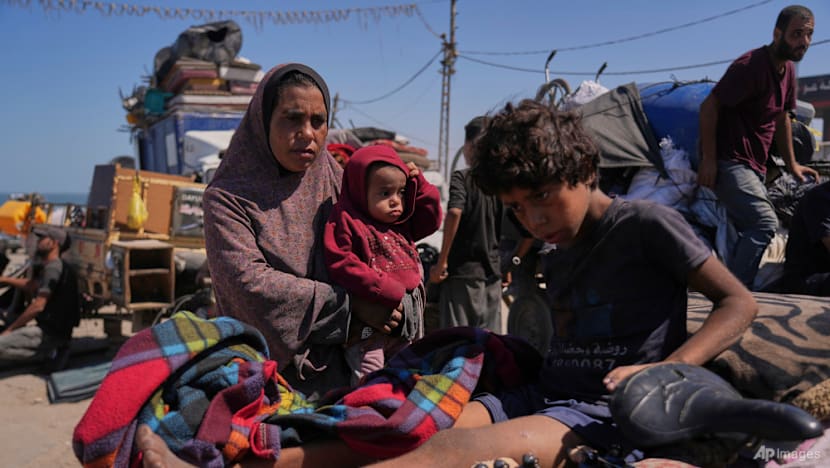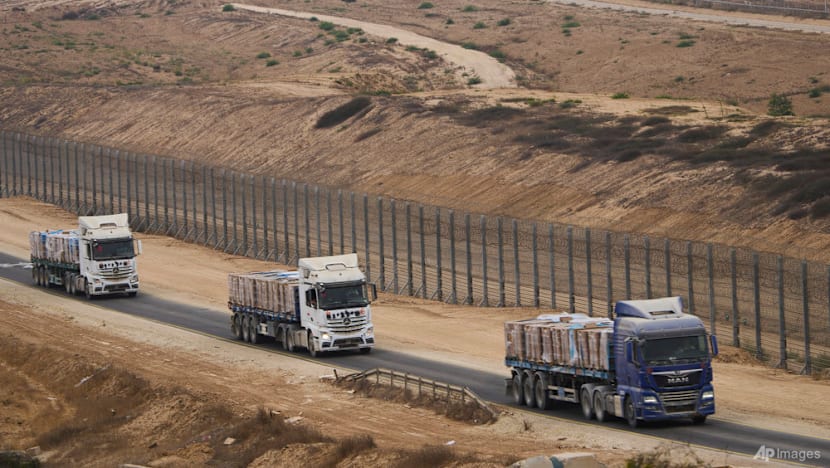Aid groups ready humanitarian push for Gaza following ceasefire deal
Supplies have been turned back at checkpoints and stuck in neighbouring countries due to Israeli restrictions on entry into Gaza, said aid organisations.

A Palestinian man carries an aid box distributed by the United Nations Relief and Works Agency (UNRWA) in Deir Al-Balah, central Gaza Strip, Nov 4, 2024. (Photo: Reuters/Ramadan Abed)

This audio is generated by an AI tool.
Global aid agencies are preparing for one of the largest humanitarian operations in recent history, as a long-awaited ceasefire between Israel and Hamas appears set to take hold.
The truce is expected to offer a fragile lifeline to Gaza’s 2.1 million residents after two years of devastating war.
The United Nations said it is ready to roll out massive aid deliveries, with trucks on standby to enter the enclave once the ceasefire takes effect.
The organisation’s Relief and Works Agency for Palestine Refugees in the Near East (UNRWA) said it has enough supplies – including food, medicine and other essentials – to sustain Gaza’s entire population for the next three months.
UN humanitarian chief Tom Fletcher said plans are underway to increase the pipeline of supplies to hundreds of trucks daily.
“We will scale up the provision of food across Gaza to reach 2.1 million people who need food aid and around 500,000 people who need nutrition,” said the under-secretary-general for humanitarian affairs and emergency relief coordinator.
“Famine must be reverted in areas where it has taken hold and prevented in others,” he added
More than half a million people in Gaza are suffering from famine, according to an August report by global hunger monitor IPC.
Shelter and cash assistance are also being ramped up ahead of winter, with 200,000 families set to receive direct financial support to meet basic needs.

“To turn this ceasefire into real progress, we need more than the silencing of the guns,” UN Secretary-General Antonio Guterres said.
“We need full, safe and sustained access for humanitarian workers, the removal of red tape and impediments, and the rebuilding of shattered infrastructure.”
An Israeli government spokesperson said the ceasefire would go into force within 24 hours of government approval of the deal, which the Israeli Cabinet agreed to on early Friday (Oct 10) morning.
AID BLOCKED AT BORDERS
Israel has come under widespread criticism for allowing just a fraction of aid into the war-torn enclave.
Humanitarian organisations said supplies have been turned back at checkpoints and stuck in neighbouring countries such as Jordan and Egypt, due to Israeli restrictions on entry into Gaza.
Israel has denied limiting aid, saying its restrictions ensure that supplies reach civilians directly rather than Hamas.

Sean Carroll, CEO of American Near East Refugee Aid (Anera), said on Friday that supplies from his US-based aid group have been “sitting at the border for many months”.
“(We) have 750 tonnes of rice sitting just outside the Gaza Strip, and it's been prevented from going in,” he added. The amount of rice is enough for about six million meals.
“We're ready (to go into Gaza). But we have to make sure that the red tape that hinders aid is lowered, that all of the border crossings are open, that there is enough manpower to get all of the aid in.”
Carroll was speaking to CNA’s Asia First programme two days after United States President Donald Trump announced Israel and Hamas had agreed on the first phase of the US-brokered deal.
During a short-lived ceasefire between January and March this year, about 700 trucks entered Gaza daily. But that number has since dwindled to a trickle.
Before the conflict, at least 500 truckloads of aid entered the enclave each day.
“We need to see that number or more. We now have huge amounts of the population who are hungry, starving (and) malnourished,” said Carroll.
MASSIVE TASK TO REBUILD
The UN estimates that 90 per cent of housing units in Gaza have been damaged.
Rebuilding the enclave could cost more than US$40 billion and take decades to complete.
Clearing an estimated 50 million tonnes of debris – contaminated with unexploded ordnance and toxic waste – will be one of the most urgent and dangerous tasks.
Carroll, who visited Gaza last December, described the destruction as “enormous beyond comprehension”.
“The Palestinians are resolute. They're resourceful. They were already rebuilding, but there needs to be massive amounts of support – financial aid, expertise, innovation,” he said.
He added that the lack of aid has worsened instability, and urged unrestricted humanitarian access.
“(There’s) both desperation – families grabbing what they can – and war profiteering that breeds organised crime. The social fabric has deteriorated. We've got to get aid in so we get rid of that desperation and war profiteering,” he said.
“The parties to this ceasefire agreement and this pathway towards peace need to recognise that for this to work, there really needs to be unfettered access to everything that's needed for recovery and rebuilding.”
UNCERTAINTIES AHEAD
Despite optimism over the ceasefire agreement, analysts warn that it is only the first step in a complex and uncertain peace process.
The deal, hailed by Trump as a “historic moment”, is a phased plan involving partial Israeli troop withdrawal, the release of hostages, and eventually, Gaza’s reconstruction. There will also be a “Board of Peace” headed by Trump and involving former British Prime Minister Tony Blair.
Dilnoza Ubaydullaeva, a lecturer at The Australian National University’s National Security College, cautioned that the agreement’s long-term implementation remains uncertain.
“It’s a short-term plan. There are concerns … given the past experiences of disagreements and erosion of trust,” she told CNA938, referring to previous failed truce agreements.
“For the Palestinian people in general … from a democracy perspective, does it represent the will of the people? Or would it be another form of neocolonial approach?”
Many of the toughest political questions remain unresolved – including the release of Palestinian prisoners, the fate of Hamas, and who will govern Gaza after the war.
“Those are big challenges. There are quite a few moving parts in this arrangement and the risk of failure is very high,” said Shahram Akbarzadeh, director of Deakin University’s Middle East Studies Forum.
Still, he said Trump’s personal stake in the deal could help sustain momentum.
“(But) the fact that Trump has put his own credibility on the line is significant. It gives this push for ceasefire and hopefully peace … a lot of hope, because he wants it to succeed. Trump wants to win the Nobel Peace Prize,” he added.
















